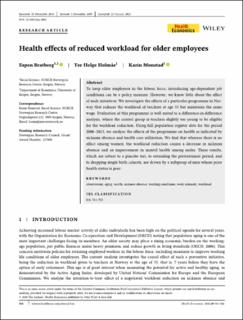| dc.contributor.author | Bratberg, Espen | |
| dc.contributor.author | Holmås, Tor Helge | |
| dc.contributor.author | Monstad, Karin | |
| dc.date.accessioned | 2021-03-09T11:47:48Z | |
| dc.date.available | 2021-03-09T11:47:48Z | |
| dc.date.created | 2020-02-03T15:30:51Z | |
| dc.date.issued | 2020 | |
| dc.Published | Health Economics. 2020, . | |
| dc.identifier.issn | 1057-9230 | |
| dc.identifier.uri | https://hdl.handle.net/11250/2732358 | |
| dc.description.abstract | To keep elder employees in the labour force, introducing age-dependent job conditions can be a policy measure. However, we know little about the effect of such initiatives. We investigate the effects of a particular programme in Norwaythat reduces the workload of teachers at age 55 but maintains the same wage. Evaluation of this programme is well suited to a difference-in-difference analysis, where the control group is teachers slightly too young to be eligible for the workload reduction. Using full population register data for the period 2006–2013, we analyse the effects of the programme on health as indicated by sickness absence and health care utilization. We find that whereas there is no effect among women, the workload reduction causes a decrease in sickness absence and an improvement in mental health among males. These results, which are robust to a placebo test, to extending the pretreatment period, and to dropping single birth cohorts, are driven by a subgroup of men whose prior health status is poor. | en_US |
| dc.language.iso | eng | en_US |
| dc.publisher | Wiley | en_US |
| dc.rights | Attribution-NonCommercial-NoDerivatives 4.0 Internasjonal | * |
| dc.rights.uri | http://creativecommons.org/licenses/by-nc-nd/4.0/deed.no | * |
| dc.title | Health effects of reduced workload for older employees | en_US |
| dc.type | Journal article | en_US |
| dc.type | Peer reviewed | en_US |
| dc.description.version | publishedVersion | en_US |
| dc.rights.holder | Copyright 2020 The Authors. | en_US |
| cristin.ispublished | true | |
| cristin.fulltext | original | |
| cristin.qualitycode | 2 | |
| dc.identifier.doi | 10.1002/hec.4002 | |
| dc.identifier.cristin | 1790365 | |
| dc.source.journal | Health Economics | en_US |
| dc.source.pagenumber | 554-566 | en_US |
| dc.relation.project | Norges forskningsråd: 257598 | en_US |
| dc.relation.project | Norges forskningsråd: 237808 | en_US |
| dc.identifier.citation | Health Economics. 2020, 29 (5), 554-566. | en_US |
| dc.source.volume | 29 | en_US |
| dc.source.issue | 5 | en_US |

